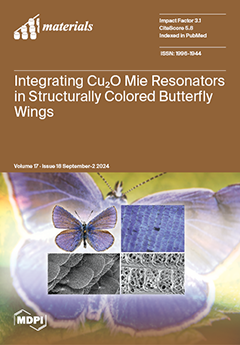High-entropy perovskite materials (HEPMs), characterized by their multi-element composition and highly disordered structure, can incorporate multiple rare earth elements at the A-site, producing perovskites with enhanced CO
2 resistance, making them stay high performance and structurally stable in the CO
2 atmosphere. However,
[...] Read more.
High-entropy perovskite materials (HEPMs), characterized by their multi-element composition and highly disordered structure, can incorporate multiple rare earth elements at the A-site, producing perovskites with enhanced CO
2 resistance, making them stay high performance and structurally stable in the CO
2 atmosphere. However, this modification may result in reduced oxygen permeability. In this study, we investigated La
0.2Pr
0.2Nd
0.2Ba
0.2Sr
0.2Co
0.8Fe
0.2O
3-δ (L
0.2M
1.8) high-entropy perovskite materials, focusing on enhancing their oxygen permeability in both air and CO
2 atmospheres through strategic design modifications at the B-sites and A/B-sites. We prepared Ni-substituted La
0.2Pr
0.2Nd
0.2Ba
0.2Sr
0.2Co
0.7Fe
0.2Ni
0.1O
3-δ (L
0.2M
1.7N
0.1) HEPMs by introducing Ni elements at the B-site, and further innovatively introduced A-site defects to prepare La
0.2Pr
0.2Nd
0.2Ba
0.2Sr
0.2Co
0.7Fe
0.2Ni
0.1O
3-δ (L
0.1M
1.7N
0.1) materials. In a pure CO
2 atmosphere, the oxygen permeation flux of the L
0.1M
1.7N
0.1 membrane can reach 0.29 mL·cm
−2·min
−1. Notably, the L
0.1M
1.7N
0.1 membrane maintained a good perovskite structure after stability tests extending up to 120 h under 20% CO
2/80% He atmosphere. These findings suggest that A-site-defect high-entropy perovskites hold great promise for applications in CO
2 capture, storage, and utilization.
Full article






